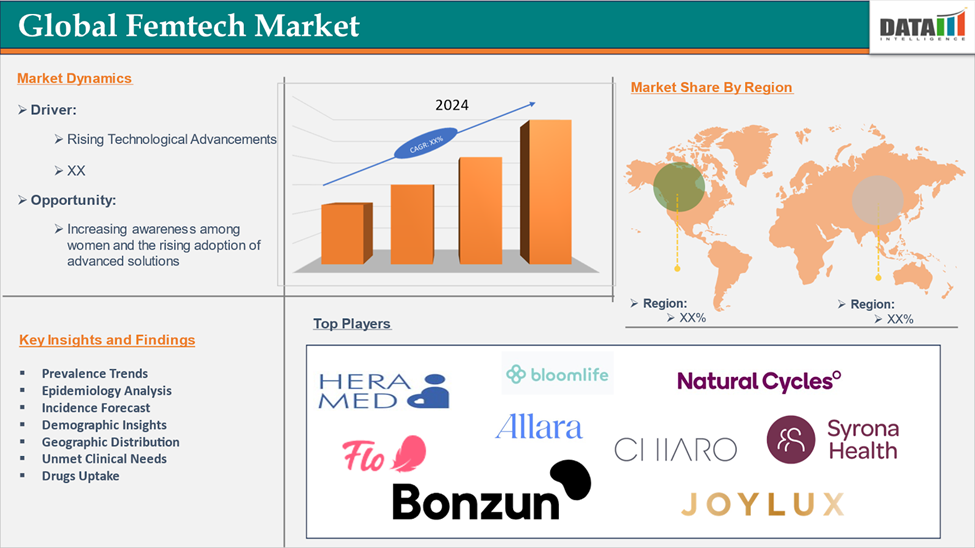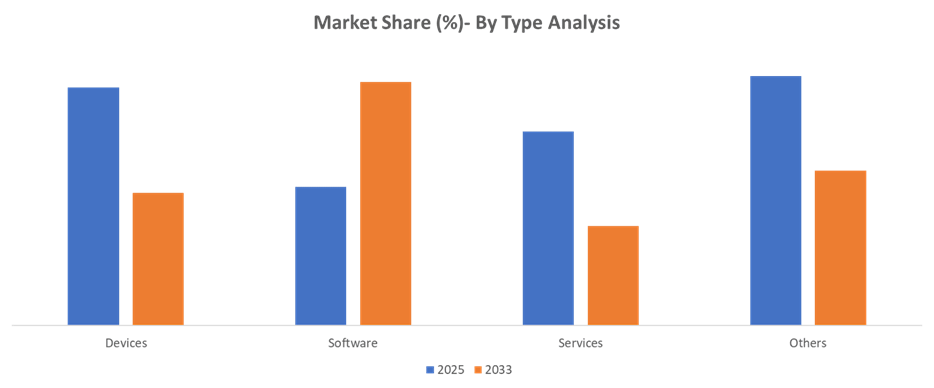Femtech Market Size
The Global Femtech Market reached US$38.90 billion in 2024 and is expected to reach US$112.30 billion by 2033, growing at a CAGR of 12.6% during the forecast period 2025-2033, according to DataM Intelligence report.
FemTech is a transformative sector within healthcare that focuses on addressing women's unique health needs through innovative solutions. It encompasses various products and services, including diagnostic tools, wearables, telemedicine platforms, and mobile applications that cater specifically to female-specific conditions such as maternal health, menstrual health, pelvic and sexual health, fertility, menopause, and contraception, as per our research.
Moreover, FemTech also addresses general health issues that disproportionately affect women, such as osteoporosis and cardiovascular diseases.
Executive Summary

For more details on this report – Request for Sample material
Market Dynamics: Drivers & Restraints
Rising Technological Advancements
Rising technological advancements are significantly driving the femtech market. The frequent launch of new, cutting-edge products, such as wearable health trackers, fertility monitors, and menstrual health devices, is further fueling market expansion. These advancements not only improve the accuracy and functionality of femtech solutions but also increase consumer trust and adoption, contributing to the continued growth of the market. For instance, in December 2023, Arva Health launched home fertility tests for women. This test helps women monitor and track their hormones, thus empowering them to make informed choices about their reproductive health.
Collaborations between tech companies, healthcare providers, and startups are accelerating innovation and enabling the development of more advanced, user-friendly devices tailored to women's health. For instance, in October 2024, Bayer entered into a partnership with Impli, an innovative, deep-tech start-up in precision care. The partnership is intended to advance early-stage research while exploring a variety of potential use cases for hormone monitoring and providing Impli with access to Bayer’s global innovation ecosystem. Thus, the above factors are expected to drive the market growth.
High production costs
High costs associated with advanced femtech devices are expected to hinder the femtech market by limiting accessibility for a large segment of potential consumers. As many femtech solutions, particularly wearables and specialized health devices, can be expensive, they may not be affordable for all users, especially in emerging markets or among lower-income populations. This price barrier can slow down adoption rates, as consumers may be hesitant to invest in these products without clear, immediate benefits. Additionally, the high costs may limit the ability of healthcare providers and insurers to offer these solutions widely, further restricting the market growth.
Market Segment Analysis
The global femtech market is segmented based on type, application, end-user, and region.

Type:
Devices segment is expected to dominate the global femtech market share
The devices segment is expected to dominate the femtech market due to the rising demand for innovative health monitoring tools tailored to women’s needs. Additionally, advances in wearable technology, such as fertility trackers, pregnancy monitoring devices, and menstrual health gadgets, are driving the segment’s growth. Several companies and organizations are introducing advanced devices to track and monitor women’s health conditions. For instance, in June 2024, Noise launched new women’s health tracking features for its smart ring, Luna. This update aims to offer personalized menstrual health insights and predictions, helping women with various menstrual patterns better understand their health.
As consumers are increasingly seeking personalized, at-home healthcare solutions, the convenience and accessibility of these devices are creating more demand for these devices. Companies are collaborating to introduce advanced devices that help individuals track their health and to incorporate advanced features in the existing devices. For instance, in February 2023, Samsung Electronics and Natural Cycles entered into a partnership to bring advanced temperature-based menstrual cycle tracking capabilities to the Galaxy Watch5 series. Furthermore, continuous technological improvements in device accuracy, user experience, and integration with digital health platforms are expected to further strengthen the dominance of the devices segment in the femtech market.
Market Geographical Share
North America is expected to hold a significant position in the global femtech market share
North America holds a major portion of the femtech market and is expected to dominate the market during the forecast period. This is due to consumers' growing adoption of femtech products and services. The rising adoption and significant investment in both healthcare and technology are additional factors contributing to the region’s market growth.
Companies are introducing the latest and most advanced solutions with the growing demand and supporting women’s health. For instance, in December 2024, ConTIPI Medical and EVERSANA announced the U.S. commercial launch of ProVate, a new non-surgical device for women experiencing pelvic organ prolapse (POP). It is a ready-to-use, disposable device for patients’ at-home use, and is now available for physicians across the U.S. to prescribe
The region’s advanced healthcare infrastructure, along with a focus on women’s health, supports the rapid growth of femtech innovations. Additionally, increasing R&D funding from both private and public sectors is accelerating the development of advanced solutions tailored to the needs of women, positioning North America in the dominant position.
Major Global Players
The major global players in the femtech market include Chiaro Technology Ltd., HeraMED, Flo Health Inc., Allara Health, Bloomlife, Syrona Health, Joylux, Inc., Coroflo Ltd., Bonzun, and Natural Cycles USA Corp among others.
| Metrics | Details | |
| CAGR | 12.6% | |
| Market Size Available for Years | 2022-2033 | |
| Estimation Forecast Period | 2025-2033 | |
| Revenue Units | Value (US$ Bn) | |
| Segments Covered | Type | Devices, Software, Services, Others |
| Application | Women’s Mental Health and Well-being, Reproductive Health, Women’s Geriatric Health, Oncology, Others | |
| End-User | Hospitals, Diagnostic Centers, Fertility Centers, Cancer Centers, Home Care, Others | |
| Regions Covered | North America, Europe, Asia-Pacific, South America, and Middle East & Africa | |
Key Developments
- In November 2024, PatientsLikeMe (PLM) launched Ella, an AI assistant to help women manage their health, powered by the generative AI platform Ema.
- 30 May 2024 — UNFPA, the United Nations Sexual and Reproductive Health Agency, launched a groundbreaking initiative to help organizations enhance their employees’ reproductive health using the world’s first sexual and reproductive health ESG indicators.
Why Purchase the Report?
- Pipeline & Innovations: Reviews ongoing clinical trials, and product pipelines, and forecasts upcoming advancements in medical devices and pharmaceuticals.
- Product Performance & Market Positioning: Analyzes product performance, market positioning, and growth potential to optimize strategies.
- Real-World Evidence: Integrates patient feedback and data into product development for improved outcomes.
- Physician Preferences & Health System Impact: Examines healthcare provider behaviors and the impact of health system mergers on adoption strategies.
- Market Updates & Industry Changes: Covers recent regulatory changes, new policies, and emerging technologies.
- Competitive Strategies: Analyzes competitor strategies, market share, and emerging players.
- Pricing & Market Access: Reviews pricing models, reimbursement trends, and market access strategies.
- Market Entry & Expansion: Identifies optimal strategies for entering new markets and partnerships.
- Regional Growth & Investment: Highlights high-growth regions and investment opportunities.
- Supply Chain Optimization: Assesses supply chain risks and distribution strategies for efficient product delivery.
- Sustainability & Regulatory Impact: Focuses on eco-friendly practices and evolving regulations in healthcare.
- Post-market Surveillance: Uses post-market data to enhance product safety and access.
- Pharmacoeconomics & Value-Based Pricing: Analyzes the shift to value-based pricing and data-driven decision-making in R&D.
The Global Femtech Market report delivers a detailed analysis with 60+ key tables, more than 50 visually impactful figures, and 176 pages of expert insights, providing a complete view of the market landscape.
Target Audience 2025
- Manufacturers: Pharmaceutical, Medical Device, Biotech Companies, Contract Manufacturers, Distributors, Hospitals.
- Regulatory & Policy: Compliance Officers, Government, Health Economists, Market Access Specialists.
- Technology & Innovation: AI/Robotics Providers, R&D Professionals, Clinical Trial Managers, Pharmacovigilance Experts.
- Investors: Healthcare Investors, Venture Fund Investors, Pharma Marketing & Sales.
- Consulting & Advisory: Healthcare Consultants, Industry Associations, Analysts.
- Supply Chain: Distribution and Supply Chain Managers.
- Consumers & Advocacy: Patients, Advocacy Groups, Insurance Companies.
- Academic & Research: Academic Institutions.